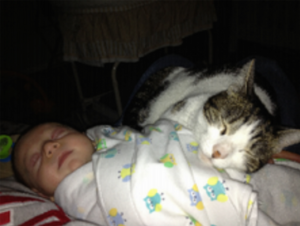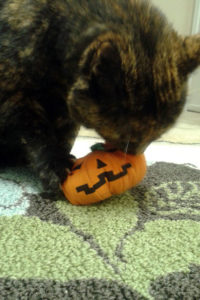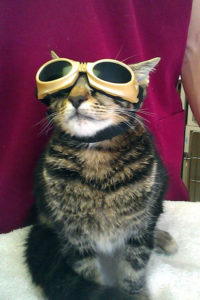Editor’s Note: The Scratching Post is a column that’s sponsored and written by the staff at NOVA Cat Clinic.
Congratulations on having a baby! We truly hope the experience is a great one for your family.
With a few simple steps we can help make sure that the transition goes as smooth as possible for both you and your felines. It is important to help manage their stress because their entire environment is about to completely change.
Start by making sure your cats have a place to retreat, preferably up high. Cat trees or shelving can aid in this. We purchased a large cat tree off Groupon a few weeks before our daughter was born. While assembling the furniture for her room, we assembled the cat tree as well. The cats seemed to appreciate their gift from the baby immediately.
 Consider using feliway and Calm diet starting a few weeks before the baby is due. Feliway is a pheromone that helps reduce stress in cats. It does not work in every cat, however I have noticed less cat to cat aggression when we use it. You can find out more information at their website.
Consider using feliway and Calm diet starting a few weeks before the baby is due. Feliway is a pheromone that helps reduce stress in cats. It does not work in every cat, however I have noticed less cat to cat aggression when we use it. You can find out more information at their website.
Calm diet is a veterinary prescription diet made by Royal Canin that contains tryptophan and casein. Think of having a large turkey dinner and a warm glass of milk. In some cats it helps them calm down. My cats tend to vomit whenever they are stressed and when we used this diet the vomiting almost ceased to exist.
The two most important aspects of a smooth transition happen after the birth of the baby. Whoever is not stuck in a hospital bed needs to go home with a few of the blankets that were with the baby for the cats to smell. Bring one blanket per cat and leave them spread throughout the living space. Spend some time with them while they smell the blankets so they associate the smell with you.
The second important thing happens when everyone comes home. Please make sure the person who did not come home with the blankets isn’t holding the baby when entering. Your cats missed you, so do not start the jealously immediately. Have a few moments of quality kitty snuggle time without the baby if possible right when you get home.
Try to spend some dedicated time with the cats everyday. Include the cats as much as possible. Anytime I breastfed, my orange cat would lay on the other side of my daughter across my lap.
The bond my daughter has created with our cats is truly amazing and I wish nothing but the same for you.
The views and opinions expressed in the column are those of the author and do not necessarily reflect the views of ARLnow.com.





 We have a
We have a